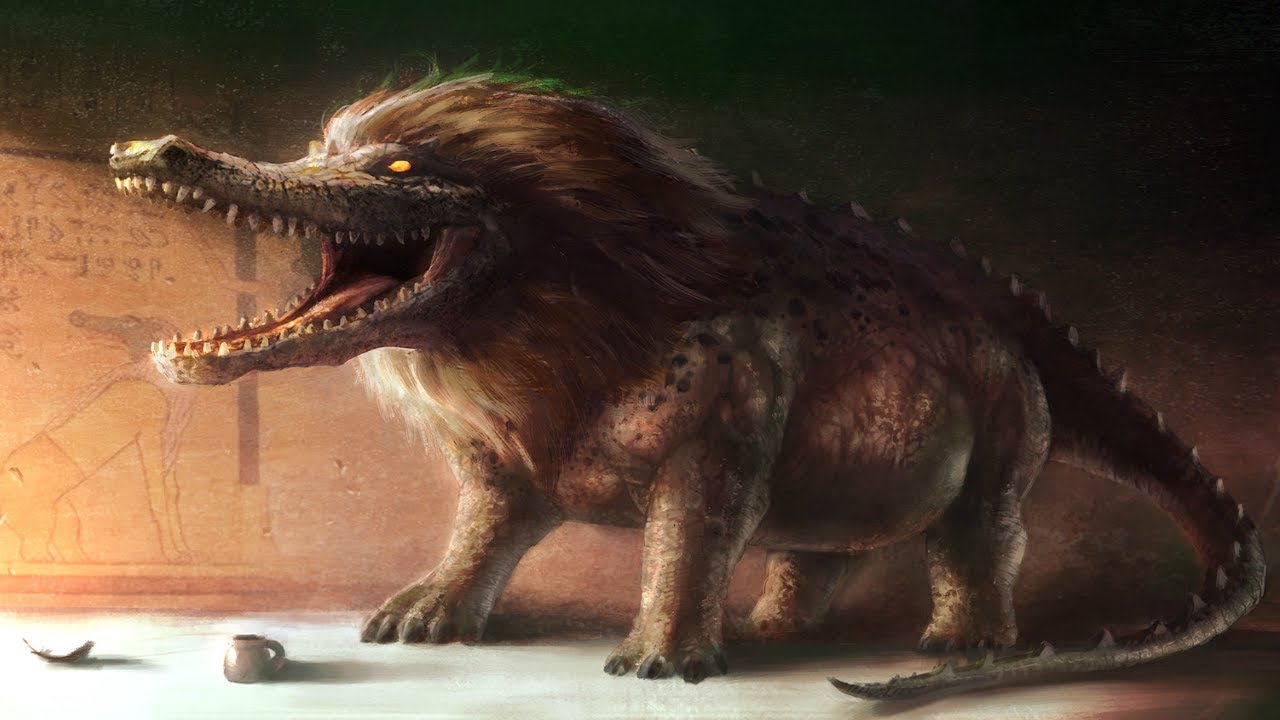In this video by Mythology & Fiction Explained, we delve into the fascinating world of Egyptian mythology and explore the intriguing figure known as Ammit, the Devourer of Souls. Ammit played a crucial role in the afterlife beliefs of ancient Egyptians, where she would consume the souls of those who were deemed unworthy to enter the realm of the afterlife. Known for her unique appearance, with the head of a crocodile, the torso of a lioness or leopard, and the lower body and hind legs of a hippopotamus, Ammit represented divine retribution and justice. While she is commonly seen as a demon, Ammit’s role was not inherently evil, but rather, she acted to enforce order, ward off evil, and represent the notion that every person is given a chance to defend their actions before final judgment. If you’re a fan of mythology and folklore, this video is bound to capture your interest, so consider subscribing to the channel for more captivating content.

Overview of Ammit: The Devourer of Souls
Introduction to Ammit in Egyptian Mythology
In Egyptian mythology, Ammit, also known as “The Devourer of Souls,” is a terrifying creature who plays a significant role in the afterlife. Often depicted as a fearsome hybrid creature with the head of a crocodile, the body of a lion, and the hindquarters of a hippopotamus, Ammit strikes fear into the hearts of those who hear her name. As a prominent figure in the mythology, Ammit is closely associated with death, judgment, and the fate of souls in the afterlife.
Ammit’s role in the Afterlife
Ammit’s primary role in Egyptian mythology is closely tied to the judgment of souls in the afterlife. According to ancient Egyptian beliefs, when a person died, their heart would be weighed against the feather of Ma’at, the goddess of truth and justice. The weighing of the heart ceremony took place in the Hall of Two Truths, where the divine tribunal presided over the proceedings.
The weighing of the heart ceremony
During the weighing of the heart ceremony, the deceased’s heart was placed on one side of a scale, while the feather of Ma’at was placed on the other. If the heart was found to be lighter than the feather, it meant that the deceased had led a virtuous life and would be granted eternal life in the afterlife. However, if the heart was heavier than the feather, it meant that the deceased had committed wicked deeds in their lifetime.
Determining the worthy and unworthy
As the heart was weighed, Ammit stood eagerly by, ready to devour the hearts of those found unworthy. She was believed to have a voracious appetite for evil and impurity, and her presence in the afterlife served as a stark reminder for individuals to live righteous lives. The judgment process in the Egyptian afterlife was a crucial aspect of the mythology, emphasizing the importance of moral conduct and the consequences of one’s actions.
The fate of those deemed unworthy
For those whose hearts were deemed heavy with sins, Ammit would swiftly devour their hearts, condemning them to eternal nonexistence. This punishment was viewed as the ultimate fate for those who failed to uphold Ma’at’s principles of truth, balance, and harmony. However, it is important to note that individuals deemed unworthy did not face immediate annihilation. The Egyptians believed in the possibility of redemption, and the unworthy souls could defend themselves in the Judgment Hall.
Ammit’s appearance and symbolism
Ammit’s appearance is a unique amalgamation of three ferocious animals, reflecting her nature as a devourer of souls. With the head of a crocodile, symbolizing power and deadly strength, she strikes fear into the hearts of the deceased. The lion’s body represents sovereignty and authority, while the hippopotamus hindquarters signify fertility and protection. Together, these animal features embody the roles that Ammit played in Egyptian mythology – as a powerful, fearsome creature embodying death and judgement.
Symbolism of Ammit’s animal hybrid form
The combination of the crocodile, lion, and hippopotamus in Ammit’s form holds symbolic meaning. The crocodile holds great significance in Egyptian mythology, representing the dangerous Nile River and its potential to both give and take life. By incorporating the lion, a symbol of kingship and strength, Ammit showcases her dominance and authority over those who face judgment. Additionally, the inclusion of the hippopotamus highlights her role as a protective force, guarding the realms of the afterlife and upholding justice.
Ammit as a demon or goddess
While Ammit is often referred to as a demon due to her terrifying appearance and her association with devouring souls, there are aspects of her that also align with the characteristics of a goddess. In Egyptian mythology, the lines between deities and demons were not always clearly defined. Ammit possessed divine powers and was instrumental in maintaining order and justice in the afterlife.
Worship and depictions of Ammit
Although Ammit was not widely worshipped in the same way as other prominent Egyptian gods and goddesses, she was revered and feared. Individuals would often make offerings or prayers to her, seeking protection from her wrath and judgment. Various depictions of Ammit have been discovered in ancient tombs, where she is portrayed as a fearsome creature lurking in the shadows, waiting to devour the hearts of the unworthy.
Ammit as a ward against evil
Despite her fearsome reputation, Ammit also served as a ward against evil. Her presence and the belief in her ability to judge and devour wickedness were meant to deter individuals from committing immoral acts. The threat of Ammit’s punishment served as a powerful reminder to maintain virtuous behavior and uphold the principles of Ma’at, ensuring a just and harmonious society.
The Book of the Dead and Ammit
Role of Ammit in the Book of the Dead
Ammit’s significance is highlighted in the ancient Egyptian funerary text known as the Book of the Dead. This collection of spells and rituals was intended to guide the deceased through the afterlife and ensure a successful passage. The Book of the Dead emphasized the importance of living a virtuous life and avoiding sins that could lead to Ammit’s judgment.
Mentions of Ammit in the funerary text
In several chapters of the Book of the Dead, Ammit is specifically mentioned as a potential threat to the deceased. The spells aimed to equip the individual with the knowledge and protection necessary to navigate the treacherous judgment process. The deceased would recite prayers and incantations to plead for mercy and forgiveness, hoping to avoid Ammit’s ravenous jaws.
Ammit’s role in guiding souls to the afterlife
While Ammit is primarily known for her role in judgment and punishment, it is also believed that she played a part in guiding souls to the afterlife. As a powerful being associated with the underworld, Ammit’s presence served as a gatekeeper, ensuring that only those deemed worthy could pass into the realms of eternal life. Her dual role as both judge and guide highlights the complex nature of Egyptian mythology and the multifaceted aspects of Ammit’s character.
Ammit as the Punisher and executioner
The role of Ammit in divine retribution
Ammit’s role as a punisher and executioner in the mythology was to maintain the balance of justice by ensuring that the wicked faced the consequences of their actions. The Egyptians believed in the concept of divine retribution, with Ammit serving as the instrument of punishment for those who had strayed from the path of righteousness.
Ammit as a symbol of justice
Ammit’s association with justice is evident in her role as the devourer of hearts. By devouring the hearts of the unworthy, she ensured that evil was eradicated and the scales of justice were balanced. Her presence in the afterlife was a reminder of the eternal consequences of one’s actions and the importance of living a righteous life.
Beliefs about Ammit’s role in punishment
Ancient Egyptians believed that Ammit’s punishment was not a form of eternal damnation but rather a path to purification and potential redemption. It was believed that souls judged unworthy by Ammit had the opportunity to present their case and defend themselves in the Judgment Hall of Two Truths. This allowed the individual a chance to demonstrate remorse and argue for a second chance.
The Judgment Hall of Two Truths
Overview of the Judgment Hall of Two Truths
The Judgment Hall of Two Truths, also known as the Hall of Ma’at, was the final destination for the deceased in the afterlife. Here, the divine tribunal presided over the weighing of the heart ceremony, where the fate of the soul would be determined. The hall was believed to be located in the underworld, and it was here that Ammit stood ready to execute her role as the devourer of souls.
Ammit’s presence and role in the hall
Ammit’s presence in the Judgment Hall of Two Truths served as a constant reminder of the punishment awaiting those who had led wicked lives. Her fearsome appearance and the legend surrounding her insatiable appetite created a sense of trepidation among the deceased. It was crucial for the deceased to prove themselves worthy of eternal life to avoid Ammit’s wrath.
The opportunity for sinners to defend themselves
Contrary to popular belief, Ammit did not immediately devour the hearts of those found unworthy. Instead, there was an opportunity for the sinners to defend themselves and plead for their right to eternal life. This process involved reciting prayers, presenting evidence of virtuous deeds, and appealing to the mercy of the gods. The outcome of this defense could determine whether their hearts would be given to Ammit or if they could continue their journey in the afterlife.
Variations in Ammit’s role
Contrasting beliefs about Ammit’s actions
While Ammit is generally known as the Devourer of Souls, certain variations in Egyptian mythology paint a different picture of her role. Some texts suggest that Ammit merely assisted in the judgment process without playing an active role in devouring hearts. In these interpretations, Ammit acts as more of a gatekeeper, waiting to carry out the will of the divine tribunal based on the outcome of the weighing of the heart ceremony.
Alternative fate for unworthy souls
In some versions of the afterlife mythology, unworthy souls were believed to face a different fate rather than being consumed by Ammit. These variations proposed that the unworthy souls would be cast into a bottomless abyss or undergo a process of eternal annihilation, where they would cease to exist in any form. These alternative versions highlight the diverse nature of Egyptian religious beliefs and the flexibility of their mythology.
Different interpretations of Ammit’s purpose
The precise nature of Ammit’s purpose and role in the afterlife has been subject to interpretation and variation throughout Egyptian history. Some scholars argue that she represents a personification of chaos and disorder, while others believe she symbolizes destruction and purification. These different interpretations contribute to the rich tapestry of Egyptian mythology and the complexity of Ammit’s character.
Conclusion
Ammit, The Devourer of Souls, occupies a significant place in Egyptian mythology due to her role in the afterlife. Through her fearsome appearance and association with judgment and punishment, Ammit played a crucial role in maintaining order and justice in the realms beyond death. Her hybrid form and presence in the Judgment Hall of Two Truths served as a powerful reminder of the consequences of one’s actions in life.
The enduring legacy of Ammit as a symbol of afterlife judgment continues to impact ancient and modern beliefs. Her representation as a devourer of souls and executioner of the unworthy serves as a cautionary tale about the importance of leading virtuous lives. The mythology surrounding Ammit’s role in the afterlife underscores the eternal struggle between good and evil, preservation and destruction, and the quest for justice and balance – themes that resonate throughout human history.
